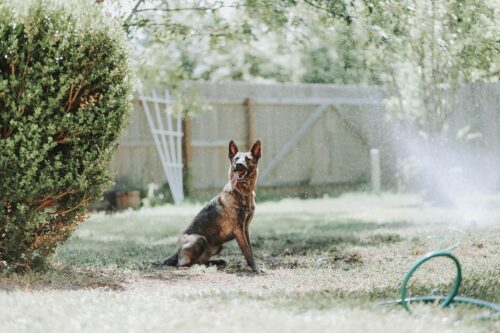Did you know that in the United States, outdoor water use averages more than 9 billion gallons per day, primarily for watering gardens and lawns?
While the figure is worrying, what’s even more worrying is that 50% of that is wasted, mostly due to inefficient sprinkler systems. Now do you see why it’s so important to check your irrigation system and sprinkler heads at least once a year?
With the arrival of summer, there’s no better time than the present to give your sprinkler system a good, thorough checkup. In fact, it’s just as important as weed control and watering! So, are you ready to enjoy a green, healthy, and lush lawn this summer?
Check out our top six tips for preparing your sprinkler system for the summer heat.
Summer Sprinkler System Preparation
It’s important to note that when you manually water your lawn, you run the risk of having the water flood certain areas, causing the grass to miss out on the proper fluids and nutrients it needs to thrive.
However, with a good water sprinkler system, the water should fall into a controlled manner in all of the right areas of your lawn which will not only benefit your grass but also help avoid wasting resources. Now that we’ve convinced you of the benefits, here’s how to prepare your sprinkler system for summer.
1. Check the soil condition first
Before setting up your sprinkler system, it is important to check the condition of the soil. It may or may not be a problem depending on where you live. Regardless, it’s a good idea to perform a pH test on your soil before starting up your sprinkler system in the spring or summer just to see where everything’s at.
Similarly, if you’re starting up your sprinkler system in early spring and the ground hasn’t thawed a foot or more before turning on the water, you may run the risk of breaking an underground pipe. Not sure when to perform a pH test on your soil? The ideal time is during the fall, actually, as it gives you time to make corrections and help heal whatever’s affecting the soil. However, doing it in spring or summer doesn’t hurt.
2. Check on the condition of your sprinkler system
When preparing your sprinkler system for summer, another basic step is going to be to perform a general check on the current status of your system. This is when you’ll get the chance to do things like install fresh batteries in your system timer and reprogram it if you turned it off during winter and spring.
You’ll want to start by checking your pipes if you have access to them and check for cracks. Repair them with a solvent cement designed specifically for irrigation systems and them move onto checking your sprinkler heads and filter screen.
Proceed with reinstalling all water feature connection components as first done. Inspecting and replacing any cracked or worn hose grommets. Similarly, examine the filter screen and clean or replace it.
Start your first test by turning on the water at a very low pressure. This will eliminate pressure surges that are strong enough to potentially break elbows in a line or cause even more serious damage to the sprinkler heads. Usually, this is the case when you haven’t used them for a while or in areas of the country with extreme cold or heat.
3. Start up your sprinkler system
Now, you’re ready to open the valve and let some water flow through. It’s a good idea to start by testing the valve that’s the furthest away from the water source. First, open it to let out any air and possible debris. Then, gradually increase the water pressure. Repeat this process as many times as necessary with each valve and keep an eye out for anything odd.
4. Inspect your drip systems
It is important not to forget to inspect the drip systems. Make a note to check everything, including drip emitters, drip lines from soaker hoses, sprinklers and bubblers.
You can do this during the first step when you’re checking your pipes for cracks, or leave it for when you’re inspecting your drip systems. And, remember that solvent cement.
5. Check the backflow prevention device
After ensuring that your drip systems are good to go, your valves are working properly and everything from the sprinkler head to the pipes are in good condition, it’s time for the inspection of the backflow prevention device.
This device keeps contaminated water out of the system, which means that it’s pretty essential. It is usually located 12” above the highest point of the system.
6. Perform a general system test
Lastly, run a test run of your sprinkler system. If your machine waters by zone, take a tour of each zone. Sprinkler heads that do not open properly in a specific area can indicate plumbing problems and will need to be fixed. Likewise, if they don’t work at all, the transformer may need to be replaced.
Sprinkler System: Essential For A Healthy Lawn
Checking and preparing your sprinkler system is very important during the summer due to warmer temperatures that can wear down parts of your irrigation system. However, it’s important to do this throughout other parts of the year as well, particularly when you’ve turned the sprinkler system off for a long period of time.
Plus, you really don’t want to be one of the Americans that contributes to the wasting of 4.5 billion gallons of water a day!
About Weld-On
Weld-On Adhesives, Inc., a subsidiary of IPS Corporation, is the pioneer and leading manufacturer of Weld-On® solvent cements, primers and cleaners for PVC, CPVC, ABS and other plastic piping systems. Weld-On products are globally recognized as the premium products for joining plastic pipes and fittings. Headquartered in California, Weld-On has state-of-the-art operations throughout the United States, as well as China, and a worldwide network of sales representatives and distributors.

